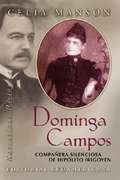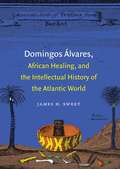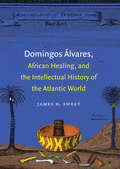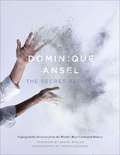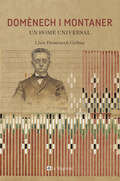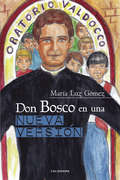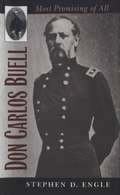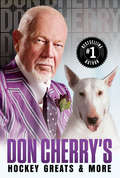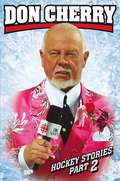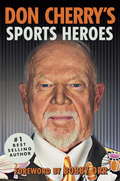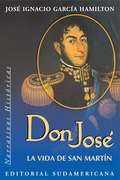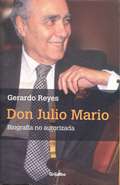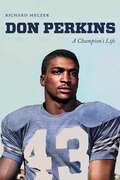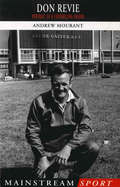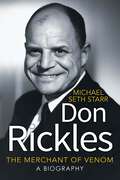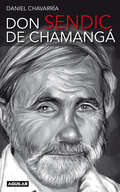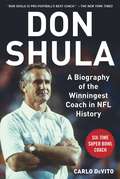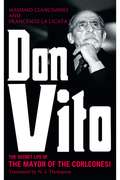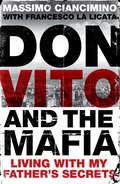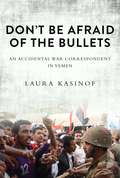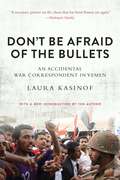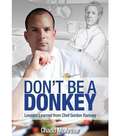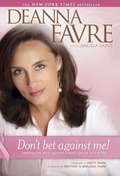- Table View
- List View
Dominga Campos
by Celia MansonSiempre se ha subrayado el carácter desconocido y oculto de la vida privada del presidente argentino Hipólito Irigoyen. No obstante hay en su vida situaciones inocultables, como lo fueron sus seis hijos y su pertinaz soltería. Esta historia da a conocer el origen, la formación y el entorno familiar de la única mujer a quien Irigoyen amó y con quien en algún momento proyectó contraer matrimonio: Dominga Campos. Hipólito Irigoyen es y será siempre un solitario. Sus biógrafos, todos hombres hasta ahora, se conmueven profundamente ante el renunciamiento familiar y afectivo que se impone. Faltaba la mirada femenina que interpretase este especial caso de amor, y este libro ha venido a llenar ese vacío.
Domingos Alvares, African Healing, And The Intellectual History Of The Atlantic World
by James H. SweetBetween 1730 and 1750, Domingos Alvares traversed the colonial Atlantic world like few Africans of his time--from Africa to South America to Europe. By tracing the steps of this powerful African healer and vodun priest, James Sweet finds dramatic means for unfolding a history of the eighteenth-century Atlantic world in which healing, religion, kinship, and political subversion were intimately connected. Alvares treated many people across the Atlantic, yet healing was rarely a simple matter of remedying illness and disease. Through the language of health and healing, Alvares also addressed the profound alienation of warfare, capitalism, and the African slave trade. As a result, he and other African healers frequently ran afoul of imperial power brokers. Nevertheless, even the powerful suffered isolation in the Atlantic world and often turned to African healers for answers. In this way, healers simultaneously became fierce critics of Atlantic imperialism and expert translators of it, adapting their therapeutic strategies in order to secure social relevance and even power. By tracing Alvares' frequent uprooting and border crossing, Sweet illuminates how African healing practices evolved in the diaspora, contesting the social and political hierarchies of imperialism while also making profound impacts on the intellectual discourse of the "modern" Atlantic world.
Domingos Álvares, African Healing, and the Intellectual History of the Atlantic World
by James H. SweetBetween 1730 and 1750, Domingos lvares traversed the colonial Atlantic world like few Africans of his time--from Africa to South America to Europe. By tracing the steps of this powerful African healer and vodun priest, James Sweet finds dramatic means for unfolding a history of the eighteenth-century Atlantic world in which healing, religion, kinship, and political subversion were intimately connected. lvares treated many people across the Atlantic, yet healing was rarely a simple matter of remedying illness and disease. Through the language of health and healing, lvares also addressed the profound alienation of warfare, capitalism, and the African slave trade. As a result, he and other African healers frequently ran afoul of imperial power brokers. Nevertheless, even the powerful suffered isolation in the Atlantic world and often turned to African healers for answers. In this way, healers simultaneously became fierce critics of Atlantic imperialism and expert translators of it, adapting their therapeutic strategies in order to secure social relevance and even power. By tracing lvares' frequent uprooting and border crossing, Sweet illuminates how African healing practices evolved in the diaspora, contesting the social and political hierarchies of imperialism while also making profound impacts on the intellectual discourse of the "modern" Atlantic world.
Dominique Ansel: The Secret Recipes
by Dominique AnselHow do you catch lightning in a measuring cup?Dominique Ansel is the creator of the Cronut™, the croissant-doughnut hybrid that has taken the world by storm. But he’s no one-hit wonder. Classically trained in Paris, responsible for a four-star kitchen in New York, and now the proprietor of New York’s highest rated bakery, Ansel has become a modern-day Willy Wonka: the creator of wildly creative, extraordinarily delicious, and unbelievably popular desserts. Now, in his hotly anticipated debut cookbook, Ansel shares the secret to transforming the most humble ingredients into the most extraordinary, tempting, and satisfying pastries imaginable. Dominique Ansel: The Secret Recipes reveals the stories and recipes behind his most sought-after creations and teaches lovers of dessert everywhere how to make magic in their own kitchens.
Domènech i Montaner: Un home universal
by Lluís Domènech GirbauL’obra que acull tota la riquesa d’un home polifònic que va transcendir la seva època per convertir-se en un referent cultural immortal. L'arquitecte Lluís Domènech i Montaner (1849-1923) ha estat qualificat, amb raó, d'home universal. Figura fonamental de la Catalunya del tombant del segle XIX i començaments del XX, la seva obra va anar més enllà de l'àmbit arquitectònic gràcies a la seva activa participació en la vida cultural i política del seu temps. Artífex dels edificis de l'Exposició Universal del 1888 i de dues obres mestres del modernisme com l'Hospital de Sant Pau i el Palau de la Música (declarades Patrimoni de la Humanitat), Domènech i Montaner va ser també un nom destacat de la Renaixença, va presidir les Bases de Manresa i va ser diputat a les Corts espanyoles, punt culminant del catalanisme polític.
Don Bosco en una nueva versión
by María Luz GómezDon Bosco fue gran maestro y amigo de los jóvenes. Juan Bosco, niño pobre con vocación sacerdotal, no tenía dinero para costearse el seminario. Lo obtuvo trabajando como titiritero. Ya sacerdote, dedicó su vida a ayudar a los chicos desamparados. Y, para que perdurara su obra, fundó la Congregación Salesiana.
Don Carlos Buell
by Stephen D. EngleMajor General Don Carlos Buell stood among the senior Northern commanders early in the Civil War, led the Army of the Ohio in the critical Kentucky theater in 1861-62, and helped shape the direction of the conflict during its first years. Only a handful of Northern generals loomed as large on the military landscape during this period, and Buell is the only one of them who has not been the subject of a full-scale biography.A conservative Democrat, Buell viewed the Civil War as a contest to restore the antebellum Union rather than a struggle to bring significant social change to the slaveholding South. Stephen Engle explores the effects that this attitude--one shared by a number of other Union officers early in the war--had on the Northern high command and on political-military relations. In addition, he examines the ramifications within the Army of the Ohio of Buell's proslavery leanings.A personally brave, intelligent, and talented officer, Buell nonetheless failed as a theater and army commander, and in late 1862 he was removed from command. But as Engle notes, Buell's attitude and campaigns provided the Union with a valuable lesson: that the Confederacy would not yield to halfhearted campaigns with limited goals.
Don Cherry's Hockey Greats and More
by Don CherryBroadcasting icon and bestselling author Don Cherry is back to give us more of what we want: behind-the-scenes sports stories that are as colourful as his wardrobe.For the last sixty years, Don Cherry has lived and breathed hockey. He has interviewed all of hockey's biggest names on Grapevine and "Coach's Corner," and he coached some of them too. But Don's interests span across all sports, and even beyond. In this unforgettable book, Don grants us unparalleled insider access to some of the most legendary athletes and figures of our time.Follow Don to the 2018 Stanley Cup playoffs and to the pitcher's mound at Rogers Centre (and learn how the Blue Jays' Josh Donaldson saved his neck). Jet back in time to meet Bobby Hull, Phil Esposito, Scotty Bowman, John Ferguson and other greats--up close and unfiltered. Discover Don's opinions on the toughest guys he ever played against, "hockey parents," the role of fighting in the game, and the Hall of Fame (and who should be in it). Learn about Don's friendship with Gord Downie--the incomparable late frontman of the Tragically Hip and a lifelong hockey fan.This is Don Cherry in all his hilarious and frank glory, spinning his yarns with the best of them.
Don Cherry's Hockey Stories, Part 2
by Don CherryYou thought you'd read them all, did you? Well, you haven't.Simultaneously loved and loathed, Don Cherry is one of the most talkative and talked-about personalities in hockey today. His more than twenty-five years as a player and coach have informed his popular Hockey Night in Canada commentary segment, "Coach's Corner." And now he's got more stories to share.In Don Cherry's Hockey Stories, Part 2, Grapes tells us about the 2010 Stanley Cup, relays the lessons he's learned both on and off the ice, and takes us inside hockey's mythical players' "code." You'll encounter familiar names from the game and find out who this idol looks up to. You'll travel back in time to Cherry's days playing in the minor leagues. You'll share his experiences of being named Coach of the Year in the NHL and in the AHL. And you'll hear from his kids about what it was like growing up with a dad like Don..Don Cherry tells it like it is, for better or for worse. You won't be disappointed.P.S. Don wants you to know it's a book the whole family can enjoy.From the Hardcover edition.
Don Cherry's Sports Heroes
by Don CherryDon Cherry has become a broadcasting legend, garnering millions of fans around the world with his "Coach's Corner" segment on Hockey Night in Canada. For over a decade, Cherry also hosted the TV show Grapevine, which brought viewers up close and personal with the biggest names in sports.Don was the interviewer and his son, Tim, produced the show. And no one in the sports world, from hockey players to boxers to curlers to umpires, turned down an invitation to appear on it. It was on that show that Don has some of his fondest memories from his many years in the biz, and, at last, in Don Cherry's Sports Heroes, he gives us behind-the-scenes access to some of his most fascinating and revealing interviews with the all-time greats. Don has his signature candidness and sizzling humour in these interviews and stories. In these pages you'll find epic stories about hockey greats Maurice "Rocket" Richard, Wayne Gretzky, Bobby Orr and Gordie Howe, to name a few, and since Grapevine TV was the place to be in the sports world, you can revel in some unforgettable stories on players in other fields, too. Don Cherry shares with the world tales that only a true insider could know. You won't be disappointed.
Don José
by José García HamiltonJosé Ignacio García Hamilton nos permite recuperar en este libro laimagen de un José de San Martín de carne y hueso, alejado del perfil dehéroe mitológico elaborado por la historia oficial. José Ignacio García Hamilton nos permite recuperar en este libro laimagen de un José de San Martín de carne y hueso, con humillaciones yesperanzas, alejado del perfil de héroe mitológico elaborado por lahistoria oficial.Las paginas de Don José nos muestran a una persona común, en suma, capazde experimentar pasiones, sufrir temores, sobrellevar grandezas yviviruna existencia azarosa plena de triunfos y frustraciones.A poco de salir, Don José se convirtió en un clásico inolvidable a lahora de abordar a San Martín desde una perspectiva moderna yesclarecedora, y recibió un caluroso apoyo de sus numerosos lectores.
Don Julio Mario: Biografia No Autorizada (Crónica Actual Ser.)
by GERARDO REYESEste libro es la bitácora del poder de ese personaje que ejerció unainfluencia tan abrumadora como invisible en la vida de millones decolombianos a través de una organización dinástica que vivía de lailusión de la omnipotencia, como alguna vez lo advirtió Enrique SantosCalderón. Es la semblanza de un seductor soberbio, sofisticado y mordazque impartía sus afectos y rencores a punta de besos y bofetadas, guiadopor las intrigas que le susurraban al oído sus auxiliares de turno. Cuando un ciudadano de a pie se detiene en una esquina de cualquiercapital de Colombia, seguramente encontrará alguna manifestación actualo reminiscente del imperio Santo Domingo: una valla de cerveza Águila,un restaurante Presto, el diario El Espectador colgado de un puestoambulante donde se venden jugos Tutti Frutti y agua Brisa, la voz deDarío Arizmendi, el director de Caracol Radio, o el paso de un avión deAvianca. Y lo más probable también es que tanto el alcalde de esa ciudadcomo el equipo de fútbol, el senador y el representante a la Cámara desu departamento hubieran sido patrocinados por don Julio Mario SantoDomingo, un hombre a quien ni el ciudadano ni los políticos vieron peroque estaba ahí, en sus vidas cotidianas y en otros paisajes másimperceptibles de la economía, influyendo en sus decisiones diarias, enlas noticias que los asombraban, en el presidente que los gobernaba, enel carro que manejaban y en las bebidas con que se emborrachaban, todoesto en un país donde se consume más cerveza que leche pasteurizada.
Don Perkins: A Champion's Life
by Richard MelzerDon Perkins led a life as one of the most honored athletes in the history of the University of New Mexico and the Dallas Cowboys. But Perkins&’s life was far more complex and, at times, controversial. He experienced the traumas of racial discrimination, death, divorce, football-related injuries, and a never-ending search for his own identity. In his search, Perkins ventured into sportscasting, public speaking, community relations, big-rig trucking, government work, and even amateur theater, where he portrayed Frederick Douglass and other famous Black leaders. Through it all, he remained a kind, unassuming, charismatic man, universally admired by family members, friends, and millions of fans. Don Perkins: A Champion&’s Life is the final tribute he so richly deserves.
Don Revie: Portrait of a Footballing Enigma
by Andrew MourantDon Revie was the football man about whom few were neutral. The Leeds United team he created was possibly the finest in the history of English league football, one of legendary endurance, it characters strong and unyeilding. Yet is remained unpopular, for many felt its voracious pursuit of honours was hallmarked by cynicism and ruthlessness.This fascinating study of Revie, one of English football's most complex and controversial figures, examines the factors and influences that moulded him. In interviews with team-mates, the footballers he managed and others who worked alongside him, Andrew Mourant reflects on the many seemingly paradoxical aspects of Revie's nature.After depicting Revie's childhood living on the breadline in Middlesbrough, from which the game was his great escape, Mourant traces his development through playing days with five league clubs to management of Leeds United, England and beyond. He also considers the legacy Revie left Leeds: a craving for a return to the days of glory and triumph he engineered. It is a turbulent story of success and failure. The tragic nature of Revie's untimely death in 1989 through motor neurone disease served only to sharpen memories of his achievements. He continues to cast a shadow over Elland Road and remains the yardstick against whom all successors are judged. Amid the triumphs, near misses and traumas, his reign brought Leeds United an era of unparalleled prosperity and stability. The story of Revie's career is one of intense dedication, willpower and pursuit of the near impossible. For some it was an inspiration; while for others its darker elements tainted the success he brought to Elland Road and all he strove to achieve for England.
Don Rickles: The Merchant of Venom
by Michael Seth StarrAn entertaining, hilarious, biting biography of &“Mr. Warmth,&” the infamously prickly comic who dominated Hollywood and Las Vegas for decades, making an artform out of heckling his friends, family and especially his audiences—and they couldn&’t get enough of it. Having ridden a wave of success that lasted more than sixty years, Don Rickles is best known as the &“insult&” comic who skewered presidents, royalty, celebrities, and friends and fans alike. But there was more to &“Mr. Warmth&” than a devilish ear-to-ear grin and lightning-fast put-downs. Rickles was a loving husband, an adoring father who suffered a devastating loss, and a loyal friend to the likes of Bob Newhart and Frank Sinatra. Don was also a young student at the American Academy of Dramatic Arts and intended to become a serious actor. But it was in small nightclubs where Rickles found success, steamrolling hecklers, honing his acerbic put-downs, and teaching the world to love being insulted.Don Rickles, The Merchant of Venom traces his career from his rise in the 1950s to a late-in-life resurgence thanks to the Toy Story franchise, his role in Scorsese&’s Casino, and scores of TV appearances from Carson to Seth Meyers. In the intervening decades, Rickles conquered every medium, including the stage, where the Vegas legend was still performing at the age of eighty-five. In his highly memorable career, he was idolized by a generation of younger comedians including Jerry Seinfeld, Jay Leno, and many others. And all along, Rickles performed in the shadow of a shocking open secret: he was the nicest man in town.
Don Sendic de Chamangá
by Daniel ChavarriaRaúl Sendic fue un Quijote de nuestro tiempo, habiendo contribuidodecididamente a que se preste atención y se mejore la vida de miles dehombres, mujeres y niños de nuestra campaña más desvalida. El Bebe Sendic fue un hombre insólito, de azarosa trayectoria y finaltrágico y heroico.Su gesta significó un punto de inflexión para el norte pobre del Uruguayde la segunda mitad del siglo xx. Se constituyó en el procurador quededicó su erudición, inteligencia y perspicacia a defender hasta lasúltimas consecuencias a los trabajadores rurales, explotados porempresarios y terratenientes que violaban sin escrúpulos cualquierrudimento de derecho laboral, dando a sus peones y jornaleros un tratotorpe y brutal.Es esa tarea de generosa nobleza la que asemeja a este oriundo deChamangá, Flores, a otro veterano de las proezas humanas, líder de otrospobres del pasado oriental: José Artigas. En su novela biográfica,Daniel Chavarría enfatiza esa imitación del prócer que tanto se propusoy consiguió su protagonista, aunque también el narrador insiste en queSendic mucho tuvo también del idealista caballero cervantino en ese afánimplacable por vengar agravios y ayudar a menesterosos.Fundador de la Unión de Trabajadores Azucareros de Artigas e incansableactivista en sindicatos diversos, pasó a ser pieza clave del Movimientode Liberación Nacional, Tupamaros. Por su lucha junto a los cañeros, susqueridos ?peludos?, y luego por sus acciones guerrilleras, debióconvertirse en uno de los fugitivos más buscados y perseguidos por lapolicía y las fuerzas armadas de épocas dictatoriales, a las que casisiempre logró burlar con estrategias por cierto novelescas yarriesgadas. Raúl Sendic fue un Quijote de nuestro tiempo, habiendo contribuidodecididamente a que se preste atención y se mejore la vida de miles dehombres, mujeres y niños de nuestra campaña más desvalida. El Bebe Sendic fue un hombre insólito, de azarosa trayectoria y finaltrágico y heroico.Su gesta significó un punto de inflexión para el norte pobre del Uruguayde la segunda mitad del siglo xx. Se constituyó en el procurador quededicó su erudición, inteligencia y perspicacia a defender hasta lasúltimas consecuencias a los trabajadores rurales, explotados porempresarios y terratenientes que violaban sin escrúpulos cualquierrudimento de derecho laboral, dando a sus peones y jornaleros un tratotorpe y brutal.Es esa tarea de generosa nobleza la que asemeja a este oriundo deChamangá, Flores, a otro veterano de las proezas humanas, líder de otrospobres del pasado oriental: José Artigas. En su novela biográfica,Daniel Chavarría enfatiza esa imitación del prócer que tanto se propusoy consiguió su protagonista, aunque también el narrador insiste en queSendic mucho tuvo también del idealista caballero cervantino en ese afánimplacable por vengar agravios y ayudar a menesterosos.Fundador de la Unión de Trabajadores Azucareros de Artigas e incansableactivista en sindicatos diversos, pasó a ser pieza clave del Movimientode Liberación Nacional, Tupamaros. Por su lucha junto a los cañeros, susqueridos ?peludos?, y luego por sus acciones guerrilleras, debióconvertirse en uno de los fugitivos más buscados y perseguidos por lapolicía y las fuerzas armadas de épocas dictatoriales, a las que casisiempre logró burlar con estrategias por cierto novelescas yarriesgadas.
Don Shula: A Biography of the Winningest Coach in NFL History
by Carlo DeVitoIn Don Shula: A Biography of the Winningest Coach in NFL History, acclaimed sports historian Carlo DeVito captures the story of one of the greatest coaches in sports history. First distinguishing himself as a player with the Cleveland Browns (under the great Paul Brown), Baltimore Colts, and Washington Redskins, Donald Francis Shula went on to be the boy wonder of the NFL as a coach. After serving for three seasons as the defensive coordinator for the Detroit Lions, where he oversaw one of the NFL’s toughest units, Shula was named the youngest head coach in NFL history when he took over the Baltimore Colts in 1963. But after public feuding with star quarterback Johnny Unitas and owner Carroll Rosenbloom, and despite leading the team to two NFL championship games, Shula accepted the job as head coach of the perennial doormat Miami Dolphins in 1970. Within a few seasons, he took the Dolphins to three straight Super Bowls, winning twice, including the only undefeated Super Bowl championship season in 1972 behind a bruising running attack led by two 1,000 yard rushers, Larry Csonka and Mercury Morris, as well as the unheralded “No-Name Defense.” Shula won more games (328) than any other coach in NFL history, led his teams to six Super Bowls, and only posted a losing record twice in thirty-three seasons on the sideline. He was enshrined in the Pro Football Hall of Fame in 1997. Don Shula chronicles the life of one of the greatest minds ever to be involved with the game, from the dawn of modern football to the close of the twentieth century.
Don Vito
by Francesco La Licata Massimo Ciancimino N. S. ThompsonThis is the true story of Vito Ciancimino--Don Vito da Corleone, the "Mayor of the Corleones"--who spent forty years in the grip of death, mafia, politics, business deals and the secret service. Don Vito recounts years of clandestine and previously censored contacts between politicians and the mafia--between the Italian State and the Cosa Nostra. The key witness is Massimo, the penultimate and hitherto closest of Don Vito's five children, who has given his personal testament for the first time. His account rewrites some of the most important events of Italy's recent history. If Roberto Saviano's Gomorra revealed the workings of the mafia system from street level, Francesco La Licata and Massimo Ciancimino's Don Vito tells us about the people who held the reins of power. In the words of Attilio Bolzoni of Republica: "This is the portrait of a man who was a key player from post war Italy to our days in one of the most daunting of Italian affairs, a figure who inspired fear, a devil. He was friend with mafia bosses and great politicians, of killers and respectable gentlemen. Vito Ciancimino was the incarnation of power itself, maybe the most hated and feared, the most suspected and worshipped, man of Palermo and of the whole Sicilian society".
Don Vito: The Secret Life of the Mayor of the Corleonesi
by Massimo Ciancimino Francesco La LicataThis is the true story of Vito Ciancimino - Don Vito da Corleone, the 'Mayor of the Corleones' - who spent forty years in the grip of death, mafia, politics, business deals and the secret service. Don Vito recounts years of clandestine and previously censored contacts between politicians and the mafia - between the Italian State and the Cosa Nostra. The key witness is Massimo, the penultimate and hitherto closest of Don Vito's five children, who has given his personal testament for the first time. His account rewrites some of the most important events of Italy's recent history. In the words of Attilio Bolzoni of Republica: 'This is the portrait of a man who was a key player from post war Italy to our days in one of the most daunting of Italian affairs, a figure who inspired fear, a devil. He was friend with mafia bosses and great politicians, of killers and respectable gentlemen. Vito Ciancimino was the incarnation of power itself, maybe the most hated and feared, the most suspected and worshipped, man of Palermo and of the whole Sicilian society'. If Roberto Saviano's Gomorrah revealed the workings of the mafia system at street level, Francesco La Licata and Massimo Ciancimino's Don Vito tells us about the people who held the reins of power.
Don Vito: The Secret Life of the Mayor of the Corleonesi
by Massimo Ciancimino Francesco La LicataThis is the true story of Vito Ciancimino - Don Vito da Corleone, the 'Mayor of the Corleones' - who spent forty years in the grip of death, mafia, politics, business deals and the secret service. Don Vito recounts years of clandestine and previously censored contacts between politicians and the mafia - between the Italian State and the Cosa Nostra. The key witness is Massimo, the penultimate and hitherto closest of Don Vito's five children, who has given his personal testament for the first time. His account rewrites some of the most important events of Italy's recent history. In the words of Attilio Bolzoni of Republica: 'This is the portrait of a man who was a key player from post war Italy to our days in one of the most daunting of Italian affairs, a figure who inspired fear, a devil. He was friend with mafia bosses and great politicians, of killers and respectable gentlemen. Vito Ciancimino was the incarnation of power itself, maybe the most hated and feared, the most suspected and worshipped, man of Palermo and of the whole Sicilian society'. If Roberto Saviano's Gomorrah revealed the workings of the mafia system at street level, Francesco La Licata and Massimo Ciancimino's Don Vito tells us about the people who held the reins of power.
Don't Be Afraid of the Bullets
by Laura KasinofLaura Kasinof studied Arabic in college and moved to Yemen a few years later-after a friend at a late-night party in Washington, DC, recommended the country as a good place to work as a freelance journalist. When she first moved to Sanaa in 2009, she was the only American reporter based in the country. She quickly fell in love with Yemen's people and culture, in addition to finding herself the star of a local TV soap opera.When antigovernment protests broke out in Yemen, part of the revolts sweeping the Arab world at the time, she contacted the New York Times to see if she could cover the rapidly unfolding events for the newspaper. Laura never planned to be a war correspondent, but found herself in the middle of brutal government attacks on peaceful protesters. As foreign reporters were rounded up and shipped out of the country, Laura managed to elude the authorities but found herself increasingly isolated-and even more determined to report on what she saw.Don't be Afraid of the Bullets is a fascinating and important debut by a talented young journalist.
Don't Be Afraid of the Bullets: An Accidental War Correspondent in Yemen
by Laura KasinofLaura Kasinof studied Arabic in college and moved to Yemen a few years later--after a friend at a late-night party in Washington, DC, recommended the country as a good place to work as a freelance journalist. When she first moved to the capital city of Sanaa in 2009, she was the only American reporter based in the country. She quickly fell in love with Yemen’s people and culture, and even found herself the star of a local TV soap opera. When antigovernment protests broke out in Yemen in 2011, part of the revolts sweeping the Arab world at the time, she contacted the New York Times to see if she could cover the rapidly unfolding events for the newspaper. Laura never planned to be a war correspondent, but found herself in the middle of brutal government attacks on peaceful protesters. As foreign reporters were rounded up and shipped out of the country, Laura managed to elude the authorities but found herself increasingly isolated--and even more determined to report on what she saw. With a new foreword by the author about what has happened in Yemen since the book’s initial publication, Don’t Be Afraid of the Bullets is a fascinating and important debut by a talented young journalist.
Don't Be a Donkey
by Chadd McarthurDon't be a Donkey is a true story about the life and career of Chef Chadd McArthur. It is about the lessons, about both kitchen and life, that he learned while working for Gordon Ramsay. Eighteen hours a day, five days a week... when you work with a great chef and leader that much, his wisdom will rub off on you, and at times traumatize you. The lessons learned will stick with Chef McArthur for the rest of his life, and now, with funny stories and clever insights into working with one of the world's most well-known chefs, he's sharing them in this very audiobook. From having Chef Gordon Ramsay himself fling a ravioli at him, to the integrity with which Ramsay dealt with the death of a colleague, Chef McArthur has a lot to tell about his three years spent working in Ramsay's flagship restaurant in London, sometimes directly under the man himself. Each chapter also includes a recipe, some created wholly by the author,and some influenced by Chef Ramsay's own signature dishes. Enjoy this fresh new take on Gordon Ramsay, and the challenges of a chef who survived Ramsay's kitchen for years.
Don't Bend Over in the Garden, Granny, You Know Them Taters Got Eyes
by Lewis GrizzardThis time Lewis Grizzard has gone and done it--written a book about sex, as seen through his bespectacled, ironic squint. He tells us why Junior Leaguers don't do it in groups, why Baptists won't do it standing up, and why Richard Nixon never did it, among other things. Other books by this author are available in this library.
Don't Bet Against Me! Beating the Odds Against Breast Cancer and in Life
by Angela Elwell Hunt Deanna FavreFrom the book jacket: AT AGE 35, DEANNA FAVRE HAD IT ALL - A loving husband at the peak of his NFL career Two beautiful daughters A wonderful life... AND BREAST CANCER No one is immune to tragedy. Deanna Favre is living proof. A shy, small-town girl from Kiln, Mississippi, Deanna had always been perfectly content to let her famous husband steal the spotlight. Though married to the NFL's only three-time MVP, she preferred to live a life of quiet anonymity. But on December 22, 2003, the spotlight shifted. When television cameras zeroed in on a somber Deanna watching her grief-stricken husband lead the Green Bay Packers to a Monday night victory over the Oakland Raiders immediately following the death of his father, Deanna's anonymity was lost, and her life changed forever. Tragedy struck again the following October when Deanna's younger brother, Casey, was killed in an ATV accident. Four days later-still reeling from the loss of her brother--Deanna was diagnosed with breast cancer. Through it all, however, Deanna has emerged a survivor. In this candid and inspirational memoir, she shares the triumphs and the tragedies of a life lived both behind the scenes and on center stage. From her years as a single mom and her high-profile marriage to Brett, to her highly publicized battle with breast cancer and the work she is currently doing through the Deanna Favre HOPE Foundation, her story is living testament that with faith. and love, ordinary people can overcome the most extraordinary circumstances. Three years later and cancer-free, Deanna has become one of breast cancer's leading activists. As the founder of the Deanna Favre HOPE Foundation, she now travels the country to speak about the importance of early diagnosis and raises funds to provide early diagnostic services, education, and financial support for uninsured and underinsured women battling breast cancer. Deanna, Brett, and their daughters, Brittany and Breleigh, live in Hattiesburg, Mississippi. With more than three million copies of her books sold worldwide, ANGELA HUNT is the best-selling author of more than one hundred books, including The Tale of Three Trees, The Note, and Magdalene. She and her husband make their home in Florida. DEANNA FAVRE HOPE FOUNDATION A portion of the proceeds for this book will go to the Deanna Favre HOPE Foundation to provide financial support for uninsured and underinsured women battling breast cancer.
